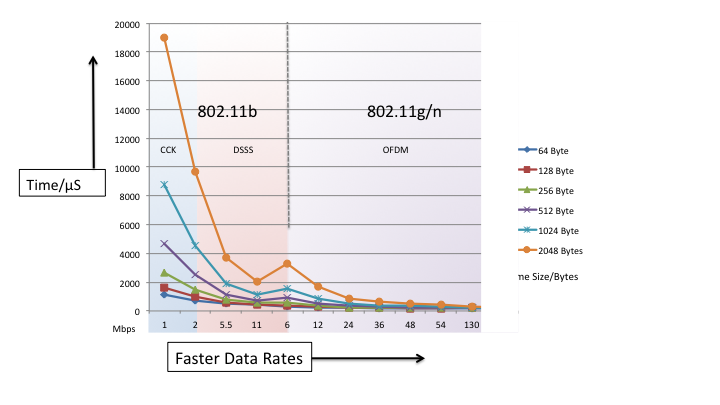































It's that time of year again in the US -Tax Time! That time of year where we review the previous year's bounty, calculate what's due, and re-evaluate our strategies to see if we can keep more of what we worked for. Things change; rules, the economy, time to retirement, and before you know it you find yourself working through alternatives and making some new decisions.
Anyway, as I was working through the schedules and rule sheets, my mind wandered and I started to think about Wi-Fi and the taxes associated with it. In my day job, I often play the role of forensic accountant. Like a tax accountant, I'm always looking for a way to get more or understand why there isn't more already. So along those lines, lets talk about a little known tax that you may well be paying needlessly. I'm talking of course about the dreaded 802.11b Penalty.
Wi-Fi protocols like 802.11b are referenced by standards committees for the workgroup that develops them. In the 2.4 GHz spectrum, there is 802.11b, 802.11g, and 802.11n. Back in 1997, 802.11b was the first modern Wi-Fi protocol ratified by the IEEE and it allowed transmissions of 11 Mbps, a major jump forward from the previous 2 Mbps that was possible with the original 802.11 standard.

After 802.11b came 802.11a, and then 802.11g. Both of these protocols where a radical departure from the simplistic 802.11b structure and employed Orthogonal frequency-division multiplexing (OFDM) modulation (now standard in every 802.11 protocol created since then). OFDM allowed formuch better air time efficiency which translated to speeds of up to 54 Mbps possible in the same amount of airtime. Part of the 802.11g specification took into account backward compatibility to support mixed environments. But this compromise, while allowing both protocols to operate in the same cell, was inefficient. An 802.11g station working in the presence of 802.11b clients must first broadcast a special message -in the 802.11b format, that lets all the 802.11b stations know that there is a message coming they wont understand, so please be quiet for a minute.
In a nutshell, here is the basis for our 802.11b "tax:"
So what? I hear you. Air-time has not changed -you still get 1 second in 1 second. And any of that time you use for something other than user data (i.e. management traffic) is air-time you can't get back. Once your airtime is used up, it is gone and that will manifest itself in all sorts of ways, like clients disconnecting, and slow network response.
Why do I mention all this? Well in most cases it's a needless waste of spectrum -and the 2.4 Ghz band with only 3 isolated channels already has less spectrum than it's bigger cousin -the 5 Ghz band. So a little goes a long way here. The truth is, unless you are in retail, logistics (warehousing) or healthcare, you very likely don't even have an 802.11b devices left on your network. If you do, hunt them down and replace them.
If, like most people implementing a wireless network, you simply accepted the defaults, then you likely still have 802.11b configured. Here's what that means -
The beacons and management traffic alone from 802.11b stack up like this -
The Channel Utilization cost for SSID's alone is 3% for every SSID, and again for each Co-Channel neighbor (another AP on the same channel you can hear). i.e. 1 SSID, on one AP = 3% cost.

NOTE -3-4 SSID's max on any one AP should be considered a best practice, if you are over 4 there's more savings you can achieve as each requires a broadcast of it's own from each AP.
In addition to the overhead created by the SSID's you also have 802.11g protection mechanism that requires sending of an 802.11b packet reserving the airtime to then send the 802.11g or 802.11n packet -that's two packets for every single user data packet -and this translates to as much as a 50% reduction of available bandwidth.
See -a very high tax indeed. Stop the madness -turn it off. Disabling 1,2,5.5, and 11 Mbps data rates will dramatically improve 2.4 GHz availability availability for usable traffic and throughput, which can translate to a savings of 30-50%.
But what if I have a consumer AP? The option is there -but not very informative. Generally there is a question when you are creating the SSID -
Answer -2 and pay significantly less taxes. This is tax avoidance, perfectly legal no tax evasion here.
As a side benefit of making your spectrum more efficient, you will also be encouraging better client behavior. By enforcing more efficient protocols you'll also likely see better battery life in those wonderful portable lifestyle managers we all hold dear, and save your channel.
As of this writing both the WFA and the IEEE are both investigating deprecating 802.11b from the standard. Beat them to the punch and get your airtime back now.
In a few years we will be looking at retiring 802.11g and 802.11a as well. Go mobile my friends.
 Горячие метки:
Информация о компании
access point
О компании AP
802.11 (к тексту на англ.)
client
battery
По каналу связи
behavior
data rate
Горячие метки:
Информация о компании
access point
О компании AP
802.11 (к тексту на англ.)
client
battery
По каналу связи
behavior
data rate